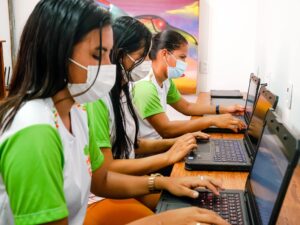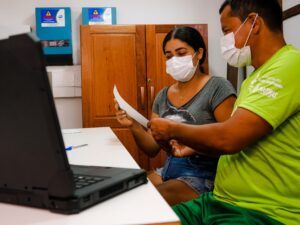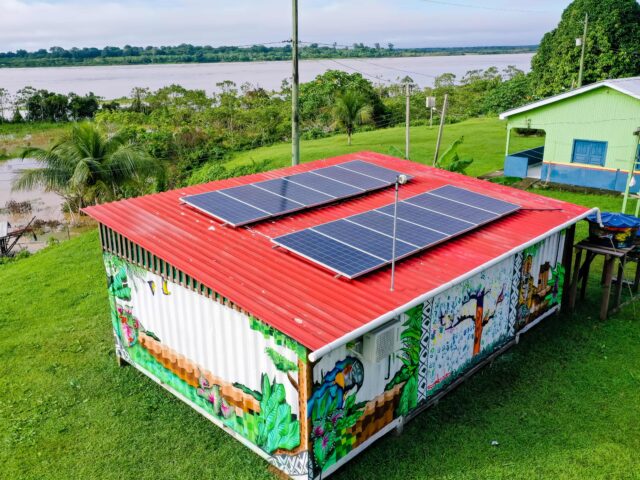By Page Motes, Senior Director, Environmental, Social & Governance, Corporate Sustainability, Dell Technologies
Wildfires, heatwaves, floods, droughts and extreme weather increasingly lead news headlines. Climate scientists have long warned that these life-threatening events are the result of climate change caused in part by deforestation. And, after years of dispute, world leaders at COP26 almost unilaterally pledged to end deforestation by 2030.
Supporting local and indigenous communities living in forests is a core part of this global commitment because they’re in the best position to help protect the trees surrounding them. This is why Dell Technologies, has partnered with Fundação Amazônia Sustentável–Foundation for Amazon Sustainability (FAS), ComputerAid, Intel and Microsoft, to run a Solar Community Hub project to help the Boa Esperança community track and reverse deforestation in the Amazon.

The riverine Nova Esperança community is located in the Rio Amapá Sustainable Development Reserve which includes 432 families and approximately 1,500 people spread over 216,109 hectares in the Brazilian state of Amazonas. Although still in its infancy, the project is already empowering the community. By using artificial intelligence (AI) to analyze real-time data gathered from drones and local environmental monitors, it is successfully tracking deforestation and assessing how to reverse it.
By sharing the learnings from the deforestation work, it is hoped that we can create a blueprint for future deforestation initiatives worldwide. It’s not as simple as issuing dictates to halt deforestation and restore the forests; we also need to preserve the indigenous and riverside communities’ traditional way of life while providing alternative avenues for revenue.
For this, they need adequate connectivity. In our Breakthrough study, most respondents were buoyant about the opportunity to operate in a hyper-connected world: 85% believe they would be more efficient and achieve more. This progress should be available to all.
To understand how the Boa Esperança community uses technology to help combat deforestation so that it can remain self-sufficient on the land that it has lived on for generations, I spoke to Anderson Mattos, manager of the education for sustainability program at FAS, who oversees the project.
Now, I’m very familiar with the Amazon Solar Community Hub Project. But for our readers, can you briefly explain how the hub began?
The partnership began in 2019 when Dell Technologies approached FAS about implementing a Solar Community Hub here. The remote Boa Esperança community was judged to be well-placed for the project because it’s located far from the region’s capital Manaus, and they wanted to position the hub deep in the rainforest.
One of the reasons that the project has worked so well is because, from the start, Dell Technologies and its partners listened to the needs of the community and adapted the project accordingly.
How has the hub helped to meet the community’s needs while tackling deforestation?
Although the community has electricity, it is not reliable, and a storm can leave it without power for days. The hub gives them their own energy source, which powers computers, mobile phones and drones, and this allows them to run the three main components of the project, covering education, health and the environment.

We also added a cistern to catch rainwater. This is an exigent measure while the Rio Madeira (Wood River), that surrounds the community, remains heavily polluted by illegal mining activities that spread mercury and other minerals. Until this is stopped, and the river is restored to good health, the community needs to draw fresh water from an alternative supply.
The community can now access the educational courses that they asked for. This includes classes on computer science and entrepreneurship, which help people discover new ways to generate income and support their families. And there are classes on the environment and environmental law, as well as the practicalities of running professional events (so they’re able to receive visitors and monetize accordingly). Together they highlight sustainable socio-economic opportunities born from the forest to demonstrate that the forest is worth more standing than cut.
How are you using drones to combat deforestation?
The drones, as well as cameras and vehicles, are being used to gather satellite images of the rainforest. We have trained community members to fly these drones. We then apply AI to assess which areas are most at risk of deforestation now–using real-time data–and which areas could be at risk soon. This includes identifying where trees are being cut down or burnt to plant crops or for illegal gold mining. Mining is a real problem for us. Many men want to mine because it pays well but they don’t always see how damaging it is to the forest, and their community.
So, we’re also training community members to support the AI by tagging the images. The process educates our young people about how destructive illegal mining is and gives them modern-day data analytical skills. Moreover, it paves the way for them to take up our courses so they can find more sustainable and rewarding ways of making a living.
 Are some demographics within the community more involved with the hub than others?
Are some demographics within the community more involved with the hub than others?
Most people in the community engage with the hub however, women and younger people are particularly keen to take up the courses, especially in computing and coding. We also run activities for children where they learn about computers and the environment through play, which are very popular. So, we’re preparing the next generation for a world of work beyond deforestation.
Do you know how much forest the hub has saved so far?
We do not have any specific data on this yet because we are in the initial phase of the environmental monitoring, but we are moving on to the next stage, where we’ll be measuring the areas of the forest that we have saved from destruction.
We are also in the process of visiting families in the community and asking them to fill in questionnaires about the area. We want to see how wood has been used in these areas in the past and how it is being used now. If we track these responses over time, we’ll be able to see whether we’ve influenced community practices, for the better.
How confident is the community in the long-term success of the hub?
FAS has been working with this community for 13 years, so they already had confidence that the hub is something they can trust and will benefit their lives. The pilot stage has reinforced this optimism. All the classes are full, and people are making suggestions for additional courses.
They recently received seedlings of native trees to plant, which was very well received. They are seeing how we are helping to heal the forest, and they’re recognizing the role they can play in becoming effective sustainability ambassadors for the Amazon. I think most importantly, we’re showing them that they can advance different skills and still maintain their traditional way of life. In fact, they’re safeguarding their futures.

